ASUS TXP4 User Manual

R TXP4 |
Pentium® Motherboard
USER’S MANUAL

USER'S NOTICE
No part of this manual, including the products and software described in it, may be reproduced, transmitted, transcribed, stored in a retrieval system, or translated into any language in any form or by any means, except documentation kept by the purchaser for backup purposes, without the express written permission of ASUSTeK COMPUTER INC. (“ASUS”).
ASUS PROVIDES THIS MANUAL “AS IS” WITHOUT WARRANTY OF ANY KIND, EITHER EXPRESS OR IMPLIED, INCLUDING BUT NOT LIMITED TO THE IMPLIED WARRANTIES OR CONDITIONS OF MERCHANTABILITY OR FITNESS FOR A PARTICULAR PURPOSE. IN NO EVENT SHALL ASUS, ITS DIRECTORS, OFFICERS, EMPLOYEES OR AGENTS BE LIABLE FOR ANY INDIRECT, SPECIAL, INCIDENTAL, OR CONSEQUENTIAL DAMAGES (INCLUDING DAMAGES FOR LOSS OF PROFITS, LOSS OF BUSINESS, LOSS OF USE OR DATA, INTERRUPTION OF BUSINESS AND THE LIKE), EVEN IF ASUS HAS BEEN ADVISED OF THE POSSIBILITY OF SUCH DAMAGES ARISING FROM ANY DEFECT OR ERROR IN THIS MANUAL OR PRODUCT.
Product warranty or service will not be extended if: (1) the product is repaired, modified or altered, unless such repair, modification of alteration is authorized in writing by ASUS; or (2) the serial number of the product is defaced or missing.
Products and corporate names appearing in this manual may or may not be registered trademarks or copyrights of their respective companies, and are used only for identification or explanation and to the owners’ benefit, without intent to infringe.
•Intel, LANDesk, and Pentium are registered trademarks of Intel Corporation.
•IBM and OS/2 are registered trademarks of International Business Machines.
•Symbios is a registered trademark of Symbios Logic Corporation.
•Windows and MS-DOS are registered trademarks of Microsoft Corporation.
•Sound Blaster AWE32 and SB16 are trademarks of Creative Technology Ltd.
•Adobe and Acrobat are registered trademarks of Adobe Systems Incorporated.
The product name and revision number are both printed on the product itself. Manual revisions are released for each product design represented by the digit before and after the period of the manual revision number. Manual updates are represented by the third digit in the manual revision number.
For previous or updated manuals, BIOS, drivers, or product release information, contact ASUS at http://www.asus.com.tw or through any of the means indicated on the following page.
SPECIFICATIONS AND INFORMATION CONTAINED IN THIS MANUAL ARE FURNISHED FOR INFORMATIONAL USE ONLY, AND ARE SUBJECT TO CHANGE AT ANY TIME WITHOUT NOTICE, AND SHOULD NOT BE CONSTRUED AS A COMMITMENT BY ASUS. ASUS ASSUMES NO RESPONSIBILITY OR LIABILITY FOR ANY ERRORS OR INACCURACIES THAT MAYAPPEAR IN THIS MANUAL, INCLUDING THE PRODUCTS AND SOFTWARE DESCRIBED IN IT.
Copyright © 1998 ASUSTeK COMPUTER INC. All Rights Reserved.
Product Name: |
ASUS TXP4 |
Manual Revision: |
2.00 |
Release Date: |
February 1998 |
|
|
2 |
ASUS TXP4 User’s Manual |

ASUS CONTACT INFORMATION
ASUSTeK COMPUTER INC.
Marketing
Address: |
150 Li-Te Road, Peitou, Taipei, Taiwan 112 |
Telephone: |
+886-2-2894-3447 |
Fax: |
+886-2-2894-3449 |
Email: |
info@asus.com.tw |
Technical Support
Fax: +886-2-2895-9254
BBS: +886-2-2896-4667
Email: tsd@asus.com.tw
WWW:www.asus.com.tw
FTP: ftp.asus.com.tw/pub/ASUS
ASUS COMPUTER INTERNATIONAL
Marketing
Address: |
6737 Mowry Ave, Mowry Business Center, Building 2, |
|
Newark, CA 94560, USA |
Fax: |
+1-510-608-4555 |
Email: |
info-usa@asus.com.tw |
Technical Support
Fax: +1-510-608-4555
BBS: +1-510-739-3774
Email: tsd-usa@asus.com.tw
WWW:www.asus.com
FTP: ftp.asus.com.tw/pub/ASUS
ASUS COMPUTER GmbH
Marketing
Address: |
Harkort Str. 25, 40880 Ratingen, BRD, Germany |
Telephone: |
49-2102-445011 |
Fax: |
49-2102-442066 |
Email: |
info-ger@asus.com.tw |
Technical Support
Hotline: 49-2102-499712
BBS: 49-2102-448690
Email: tsd-ger@asus.com.tw
WWW:www.asuscom.de
FTP: ftp.asuscom.de/pub/ASUSCOM
ASUS TXP4 User’s Manual |
3 |

CONTENTS
I. INTRODUCTION ........................................................................... |
7 |
How this manual is organized .......................................................... |
7 |
Item Checklist .................................................................................. |
7 |
II. FEATURES .................................................................................... |
8 |
Features of the ASUS TXP4 Motherboard ...................................... |
8 |
Introduction to ASUS Smart Series of motherboards ........... |
9 |
Parts of the ASUS TXP4 Motherboard ............................................ |
11 |
III. INSTALLATION .......................................................................... |
12 |
ASUS TXP4 Motherboard Layout .................................................. |
12 |
Installation Steps .............................................................................. |
14 |
1. Jumpers ........................................................................................ |
14 |
Jumper Settings .................................................................... |
15 |
Compatible Cyrix CPU Identification .................................. |
18 |
2. System Memory (SIMM & DIMM) ........................................... |
19 |
SIMM Memory Installation .................................................. |
20 |
DIMM Memory Installation ................................................. |
21 |
3. Central Processing Unit (CPU) ................................................... |
22 |
4. Expansion Cards ......................................................................... |
23 |
.............................................................................................. |
23 |
Expansion Card Installation Procedure: ............................... |
23 |
Assigning IRQs for Expansion Cards ................................... |
23 |
Assigning DMA Channels for ISA Cards ............................. |
24 |
ISA Cards and Hardware Monitor ........................................ |
24 |
5. External Connectors .................................................................... |
25 |
Power Connection Procedures ................................................... |
33 |
IV. BIOS SOFTWARE ....................................................................... |
34 |
Support Software ............................................................................. |
34 |
Flash Memory Writer Utility ...................................................... |
34 |
Main Menu ........................................................................... |
34 |
Advanced Features Menu ..................................................... |
35 |
Managing & Updating your Motherboard’s BIOS ..................... |
36 |
6. BIOS Setup ................................................................................. |
37 |
Load Defaults ....................................................................... |
38 |
Standard CMOS Setup ............................................................... |
38 |
Details of Standard CMOS Setup ......................................... |
38 |
BIOS Features Setup .................................................................. |
41 |
Details of BIOS Features Setup ............................................ |
41 |
Chipset Features Setup ............................................................... |
43 |
Details of Chipset Features Setup ......................................... |
43 |
4 |
ASUS TXP4 User’s Manual |

CONTENTS
Power Management Setup .......................................................... |
46 |
Details of Power Management Setup ................................... |
46 |
PNP and PCI Setup .................................................................... |
48 |
Details of PNP and PCI Setup .............................................. |
49 |
Load BIOS Defaults ................................................................... |
50 |
Load Setup Defaults ................................................................... |
50 |
Supervisor Password and User Password .................................. |
51 |
IDE HDD Auto Detection .......................................................... |
52 |
Save & Exit Setup ...................................................................... |
53 |
Exit Without Saving ................................................................... |
53 |
ASUS Smart Motherboard Support CD 3.10 ................................... |
55 |
Desktop Management Interface (DMI) ............................................ |
56 |
Introducing the ASUS DMI Configuration Utility ............... |
56 |
System Requirements ........................................................... |
56 |
Using the ASUS DMI Configuration Utility ........................ |
57 |
VI. ASUS PCI SCSI Cards ................................................................ |
59 |
Symbios SCSI BIOS and Drivers .................................................... |
59 |
ASUS PCI-SC200 & PCI-SC860 SCSI Cards ................................ |
59 |
Setting Up the ASUS PCI-SC200 & PCI-SC860 ....................... |
60 |
Setting the INT Assignment for the ASUS PCI-SC200 ............. |
60 |
Terminator Requirements for SCSI Devices .............................. |
60 |
Terminator Settings for the ASUS PCI-SC860 .......................... |
61 |
Terminator Settings for the ASUS PCI-SC200 .......................... |
61 |
SCSI ID Numbers for SCSI Devices ......................................... |
62 |
SCSI ID Priority ......................................................................... |
62 |
VII. ASUS LAN Card ......................................................................... |
63 |
ASUS PCI-L101 Fast Ethernet Card ............................................... |
63 |
Features ............................................................................................ |
64 |
Software Driver Support ............................................................ |
64 |
Question and Answer ................................................................. |
64 |
ASUS TXP4 User’s Manual |
5 |

FCC & DOC COMPLIANCE
Federal Communications Commission Statement
This device complies with FCC Rules Part 15. Operation is subject to the following two conditions:
•This device may not cause harmful interference, and
•This device must accept any interference received, including interference that may cause undesired operation.
This equipment has been tested and found to comply with the limits for a Class B digital device, pursuant to Part 15 of the FCC Rules. These limits are designed to provide reasonable protection against harmful interference in a residential installation. This equipment generates, uses and can radiate radio frequency energy and, if not installed and used in accordance with manufacturer’s instructions, may cause harmful interference to radio communications. However, there is no guarantee that interference will not occur in a particular installation. If this equipment does cause harmful interference to radio or television reception, which can be determined by turning the equipment off and on, the user is encouraged to try to correct the interference by one or more of the following measures:
•Re-orient or relocate the receiving antenna.
•Increase the separation between the equipment and receiver.
•Connect the equipment to an outlet on a circuit different from that to which the receiver is connected.
•Consult the dealer or an experienced radio/TV technician for help.
WARNING! The use of shielded cables for connection of the monitor to the graphics card is required to assure compliance with FCC regulations. Changes or modifications to this unit not expressly approved by the party responsible for compliance could void the user’s authority to operate this equipment.
Canadian Department of Communications Statement
This digital apparatus does not exceed the Class B limits for radio noise emissions from digital apparatus set out in the Radio Interference Regulations of the Canadian Department of Communications.
6 |
ASUS TXP4 User’s Manual |

I. INTRODUCTION
How this manual is organized
This manual is divided into the following sections:
I.Introduction: Manual information and checklist
II.Features: Information and specifications concerning this product
III. Installation: Instructions on setting up the motherboard IV. BIOS Software: Instructions on setting up the BIOS software V. Support Software: Information on the included support software VI. ASUS SCSI Cards: Installation of ASUS SCSI cards (optional) VII. ASUS L101 Card: Installation of the ASUS LAN card (optional)
Item Checklist
Please check that your package is complete. If you discover damaged or missing items, please contact your retailer.
(1) ASUS Motherboard
(1) 9pin male serial + 25pin male serial external connector set
(1) 25pin female parallel + 6pin female PS/2 mouse external connector set
(1) IDE ribbon cable for master and slave drives
(1) Floppy ribbon cable for (1) 5.25inch floppy and (2) 3.5inch floppies
(1) bag of spare jumpers
(1) diskette or CD with support drivers and utilities:
•Flash Memory Writer utility to update the onboard programmable BIOS
•Desktop Management Interface (DMI) utility
•Readme files for descriptions and use of the files
•Technical Support Form
(1) User’s Manual
PS/2 Mouse, Infrared, USB1, and USB2 external connector module (optional)
ASUS PCI-SC200 Fast-SCSI or PCI-SC860 Ultra-Fast SCSI card (optional) ASUS PCI-L101 Wake-on-LAN 10/100 Ethernet Card (optional)
I. INTRODUCTION |
(Sections/Checklist) |
|
|
ASUS TXP4 User’s Manual |
7 |

FEATURES .II (Features)
II. FEATURES
Features of the ASUS TXP4 Motherboard
The ASUS TXP4 is carefully designed for the demanding PC user who wants many intelligent features in a small package. This motherboard:
•Intel Chipset: Features Intel’s 430TX PCIset with I/O subsystems.
•Multi-Processor/Multi-Speed Support: Intel Pentium® 75–233MHz (P55C-MMX™ , P54C/P54CS), IBM® /Cyrix® 6x86-PR166+ (Rev 2.7 or later), IBM® /Cyrix® 6x86MX™ (PR166 & faster), AMD-K5™ (PR75–PR133), AMD-K6™ (PR166 & faster).
•Versatile Memory Support: Is equipped with two DIMM sockets to support 8-256MB 168-pin 3.3Volt SDRAM/EDO memory modules up to 256MB. Is also equipped with four SIMM sockets to support 4-64MB 72-pin Fast Page Mode (FPM) or Extended Data Out (EDO) memory modules up to 256MB. SIMMs and DIMMs cannot be used at the same time.
•Easy Installation: Is equipped with BIOS that supports auto detection of hard drives, PS/2 mouse, and Plug and Play devices to make setup of hard drives, expansion cards, and other devices virtually automatic.
•Dual Power Supply: Has both AT and ATX power connectors onboard to support an AT or ATX power supply with soft-on/off features.
•ISA and PCI Expansion Slots: Provides three 16-bit ISA slots and four 32-bit PCI slots.
•Super Multi-I/O: Provides two high-speed UART compatible serial ports and one parallel port with EPP and ECP capabilities. UART2 can also be directed from COM2 to the Infrared Module for wireless connections.
•Desktop Management Interface (DMI): Supports DMI through BIOS which allows hardware to communicate within a standard protocol creating a higher level of compatibility. (Requires DMI-enabled components.) (See section V)
•PCI Bus Master IDE Controller: Comes with an onboard PCI Bus Master IDE controller with two connectors that supports four IDE devices in two channels, supports PIO Modes 3 and 4 and Bus Master IDE DMA Mode 2, and supports Enhanced IDE devices such as Tape Backup and CD-ROM drives. Supports two drives of either 5.25-inch (360KB or 1.2MB) or 3.5-inch (720KB, 1.44MB, or 2.88MB) disk drives. Supports Japanese “Floppy 3 mode” (3.5- inch disk drive: 1.2MB) and LS-120 floppy disk drives (3.5-inch disk drive: 120 MB, 1.44MB, 720K). BIOS supports IDE CD-ROM or SCSI device boot-up.
•Level 2 Cache: 512KB Pipelined Burst SRAM onboard.
•Optional PS/2 Mouse, USB, IrDA Connector: Supports an optional cable and bracket set to mount the connectors to an unused expansion slot on the system chassis. A second IrDA connector is available for a standard individual infrared cable set.
•Symbios SCSI BIOS: Supports optional ASUS SCSI controller cards through onboard firmware.
•Wake on LAN: Supports Wake on LAN activity through optional ASUS PCIL101 Fast Ethernet card.
8 |
ASUS TXP4 User’s Manual |

II. FEATURES
Introduction to ASUS Smart Series of motherboards
Performance
•SDRAM Optimized Performance -ASUS TX97 series of motherboards support the new generation memory - Synchronous Dynamic Random Access Memory (SDRAM) which increases the data transfer rate from 264MB/s max using EDO memory to 528MB/s max using SDRAM.
•Double the IDE Transfer Speed - ASUS TX97 series of motherboards with Intel 430TX PCIset improves IDE transfer rate using Bus Master UltraDMA/33 IDE which can handle data transfer up to 33MB/s. The best of all is that this new technology is compatible with existing ATA-2 IDE specs so there is no need to upgrade current hard drives or cables.
•Concurrent PCI - Concurrent PCI allows multiple PCI transfers from PCI master busses to memory to CPU.
•ACPI Ready - ACPI (Advanced Configuration and Power Interface) is also implemented on all ASUS 430TX series of motherboards. ACPI provide more Energy Saving Features for the future operating systems (OS) supporting OS Direct Power Management (OSPM) functionality. With these features implemented in the OS, PCs can be ready around the clock everyday, yet satisfy all the energy saving standards. To fully utilize the benefits of ACPI, an ACPIsupported OS such as in the next release of Windows 95 must be used.
•PC ’97 Compliant - Both the BIOS and hardware levels of ASUS TX97 series of motherboards meet PC ’97 compliancy. The new PC 97 requirements for systems and components are based on the following high-level goals: Support for Plug and Play compatibility and power management for configuring and managing all system components, and 32-bit device drivers and installation procedures for both Windows 95 and Windows NT.
II. FEATURES (Smart Series)
ASUS TXP4 User’s Manual |
9 |

II. FEATURES
(This page was intentionally left blank)
|
|
|
|
|
|
10 |
ASUS TXP4 User’s Manual |
|

II. FEATURES
Parts of the ASUS TXP4 Motherboard
Programmable |
|
|
Flash ROM |
PS/2 Mouse, USB, IrDA |
Serial, Parallel, Floppy |
Super Multi-I/O
3 ISA Slots
4 PCI Slots
IDE Connectors
AT Power
Connector
ATX Power
4 SIMM Sockets
2 DIMM Sockets
Intel’s 430TX
PCIset
CPU ZIF
Socket 7
|
|
|
|
|
|
|
|
|
|
|
|
|
|
|
|
|
|
“Cool” Switching Voltage Regulators |
|
|
|||
512KB Pipelined |
|||||
|
|
|
|||
|
|
|
Burst L2 Cache |
||
II. FEATURES (Motherboard Parts)
ASUS TXP4 User’s Manual |
11 |
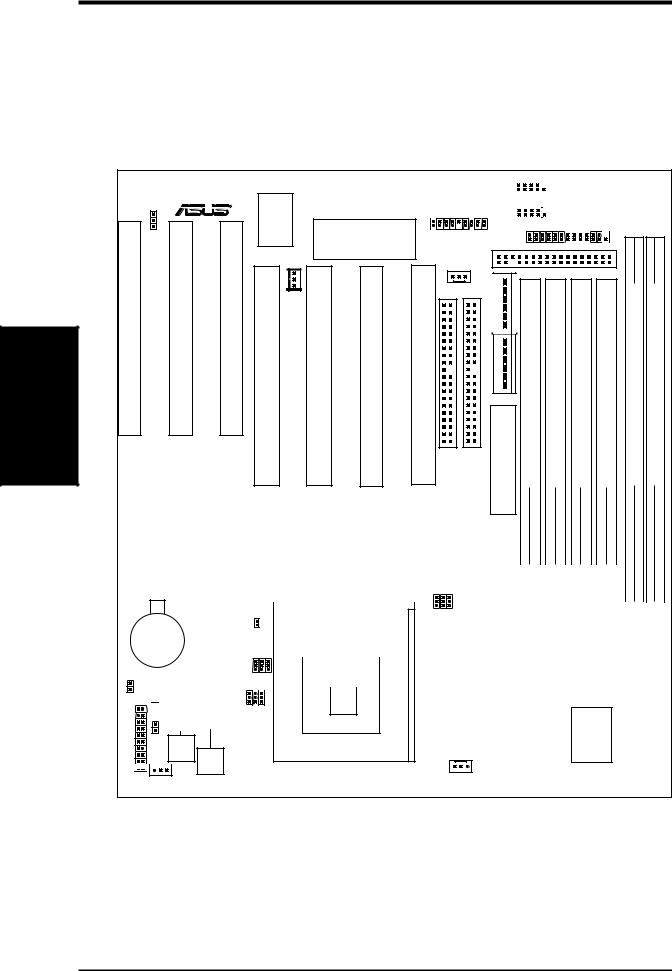
III. INSTALLATION
ASUS TXP4 Motherboard Layout
INSTALLATION .III Layout) (Motherboard
SlotISA |
WriteBlock Boot |
SlotISA |
SlotISA |
I/O-Multi |
Super |
|
|
|
|
|
R |
|
|
|
|
|
|
|
|
|
|
|
Flash BIOS |
3 |
|
2 |
1 |
PCI |
Wake |
PCI |
PCI |
|
|
|
|
Slot |
LAN on |
Slot |
Slot |
|
|
|
|
4 |
|
3 |
2 |
|
|
|
|
|
|
|
|
|
|
|
|
|
|
|
|
|
|
|
|
|
|
|
|
|
|
|
|
|
|
|
|
|
|
|
|
|
Intel |
|
|
||
|
|
|
|
|
|
|
|
|
|
|
|
|
|
|
|
PIIX4 |
|
|
||
|
|
|
|
|
|
|
|
|
|
|
|
|
|
|
|
PCIset |
|
|
||
|
|
|
|
|
|
|
|
|
|
|
|
Clear RTC |
|
|
|
|
|
|
||
|
|
|
|
|
|
|
|
ASUS ASIC |
|
|
|
|
|
|
|
|||||
|
|
|
|
|
|
|
|
|
|
|
|
|
|
|
||||||
|
|
|
|
|
|
|
|
CPU ZIF Socket 7 |
||||||||||||
|
|
CR2032 3V |
|
|
|
|
|
|
|
|
|
|||||||||
|
|
|
|
|
|
|
|
|
|
|
||||||||||
|
|
|
|
|
|
|
|
|
|
|
|
|
|
|
|
|||||
|
|
|
|
|
|
|
|
|
|
|
|
|
|
|
|
|||||
|
|
|
|
|
|
|
|
|
|
|
|
|
|
|
||||||
|
|
Lithium Cell |
|
|
|
|
BF2 BF1 BF0 |
|||||||||||||
|
BIOS Power |
|
Freq. Ratio |
|||||||||||||||||
|
|
|
|
|
|
|
|
|
|
|
|
|||||||||
|
|
|
|
VID0 |
VID2 VID1 |
|
|
|
||||||||||||
|
|
IDE LED |
|
|
|
|
|
|||||||||||||
|
|
|||||||||||||||||||
|
|
|
||||||||||||||||||
|
|
|
|
|
|
|
CPU Voltage |
|
|
|
|
|
|
|
|
|
|
|||
|
|
|
|
|
|
COM 1 |
|
|
|
|
|
|
|
|
|||||||
|
|
Serial Ports |
|
|
Key- |
|
|
||||||||||||||
|
|
|
|
|
|
|
|
|
|
|
|
board |
|
|
|||||||
PS/2 Mouse, |
|
COM 2 |
|
|
|
||||||||||||||||
|
|
|
|
|
|
|
|
|
|||||||||||||
|
|
|
|
|
|
|
|
||||||||||||||
USB, IrDA |
|
|
|
|
|
|
|
|
|
|
|
|
|
|
|
|
|
||||
|
|
|
|
|
|
|
|
|
|
|
|
|
|
|
|
|
|||||
|
|
|
|
|
Parallel (Printer) Port |
||||||||||||||||
|
|
|
|
|
|||||||||||||||||
|
|
|
|
|
|
|
|
|
|
|
|
|
|
|
|
|
|
|
|
|
|
Power Fan |
|
|
|
|
|
|
|
|
|
1 Slot PCI |
|
Input Power AT |
ATX |
Floppy Drives |
pin-72bit,-(324 Socket SIMM |
pin-168bit,-(641 Socket DIMM |
pin-168bit,-(642 Socket DIMM |
||
|
pin-72bit,-(321 Socket SIMM |
pin-72bit,-(322 Socket SIMM |
pin-72bit,-(323 Socket SIMM |
||||||
|
|
|
P9 |
|
|
|
|
|
|
|
|
|
P8 |
|
|
|
|
|
|
IDE Primary |
IDE Secondary |
|
Input Power |
module) |
module) |
module) |
module) |
module) |
module) |
Row |
0 |
1 |
|
0 |
1 |
|
2 |
3 |
|
|
2 |
3 |
|
|
|
|
|
FS2 FS1 FS0 |
|
|
|
|
|
|
|
|
|
|
|
Row 1 0 3 2 |
|||||
|
|
|
|
|
|
|
|
|
|
|
|
||||||
Clock Freq |
|
|
|
|
Intel |
|
|
|
|
|
|
|
|
|
|
||
|
|
|
|
|
|
|
|
|
|
|
|
|
|
||||
|
|
|
|
|
|
|
|
|
|
|
|
|
|
|
|||
|
|
|
|
|
430TX |
|
|
|
|
|
|
|
|||||
|
|
|
|
|
PCIset |
|
|
|
|
|
|
|
|||||
|
|
|
|
|
|
|
|
|
|
|
|
|
|
|
|
|
|
Connectors Panel



 Infrared Switching Voltage
Infrared Switching Voltage
Regulators
CPU Fan |

 Chassis
Chassis
Fan
PB 512KB
Cache L2
12 |
ASUS TXP4 User’s Manual |

III. INSTALLATION
Jumpers
1) |
BBLKW |
p. 15 |
Flash ROM Boot Block Program (Disable/Enable) |
2) |
CLRTC |
p. 15 |
Real Time Clock RAM (Clear Data) |
3) |
FS0, FS1, FS2 |
p. 16 |
CPU External Clock (BUS) Frequency Selection |
4) |
BF0, BF1, BF2 |
p. 16 |
CPU:BUS Frequency Ratio |
5) |
VID0, VID1, VID2 |
p. 18 |
CPU Voltage Selection |
Expansion Slots
1) |
SIMM Sockets |
p. 19 72-Pin SIMM Memory Expansion Sockets |
|
2) |
DIMM Sockets |
p. 19 |
168-Pin DIMM Memory Expansion Sockets |
3) |
CPU ZIF Socket 7 |
p. 22 |
Central Processing Unit (CPU) Socket |
4) |
SLOT 1, 2, 3 |
p. 23 |
16-bit ISA Bus Expansion Slots* |
5) |
PCI 1, 2, 3, 4 |
p. 23 |
32-bit PCI Bus Expansion Slots |
Connectors
1) |
KBCON |
p. 25 |
Keyboard Connector (5-pin Female) |
2) |
FLOPPY |
p. 25 |
Floppy Drive Connector (34-1pin Block) |
3) |
PRINTER |
p. 26 |
Parallel (Printer) Port Connector (26-1pin Block) |
4) |
COM1, COM2 |
p. 26 |
Serial Port COM1 & COM2 (10-1pin Blocks) |
5) |
FAN |
p. 27 |
Power Supply, Chassis, CPU Fan Power Leads |
6) |
Primary / Second IDE |
p. 28 |
Primary / Secondary IDE Connector (40-1pin Blocks) |
7) |
IDELED |
p. 28 |
IDE LED Activity Light |
8) |
ATX POWER |
p. 29 |
ATX Motherboard Power Connector (20-pin Block) |
9) |
AT POWER |
p. 29 |
AT Motherboard Power Connector (12-pin Block) |
10) |
PS2MOUSE/USB/IR |
p. 31 |
PS/2 Mouse/USB/IR Combo-Connector (18-1pin Block) |
11) |
IR |
p. 31 |
Second Infrared Port Module Connector (5-pin Block) |
12) |
MSG.LED (PANEL) |
p. 31 |
System Message LED (2 pins) |
13) |
SMI (PANEL) |
p. 31 |
SMI Switch Lead (2 pins) |
14) |
PWR SW. (PANEL) |
p. 31 |
ATX Power & Soft-Off Switch Lead (2 pins) |
15) |
RESET (PANEL) |
p. 31 |
Reset Switch Lead (2 pins) |
16) |
PWR.LED (PANEL) |
p. 31 |
System Power LED Lead (3 pins) |
17) |
KEYLOCK (PANEL) |
p. 31 |
Keyboard Lock Switch Lead (2 pins) |
18) |
SPEAKER (PANEL) |
p. 31 |
Speaker Output Connector (4 pins) |
19) |
W0L_CON |
p. 32 |
Wake on LAN Activity Connector (3-pins) |
*The onboard hardware monitor uses the address 290H-297H so legacy ISA cards must not use this address or else conflicts will occur.
III. INSTALLATION (Map of Board)
ASUS TXP4 User’s Manual |
13 |
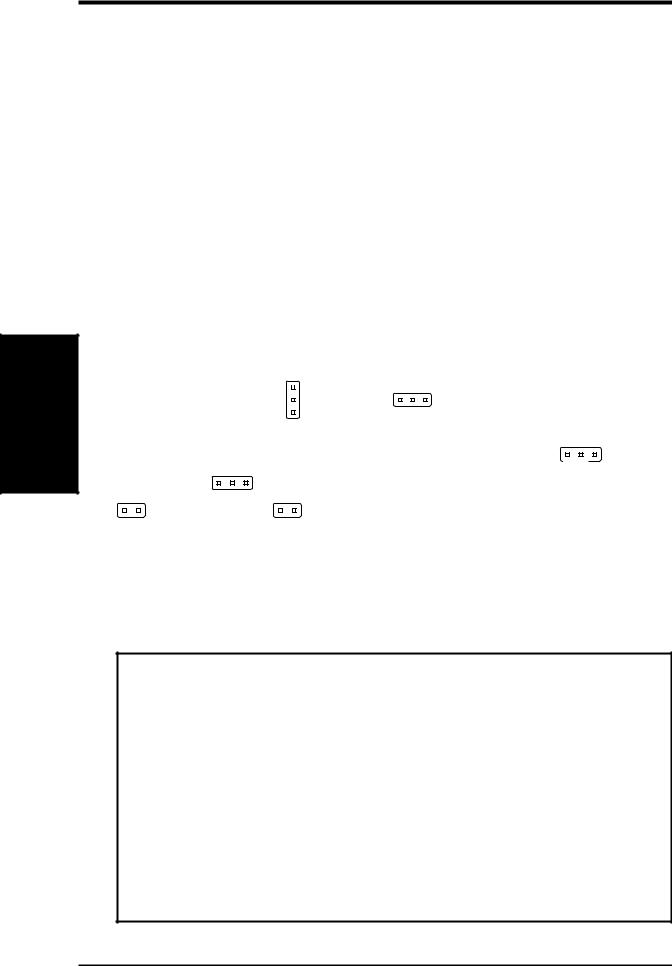
INSTALLATION .III (Jumpers)
III. INSTALLATION
Installation Steps
Before using your computer, you must complete the following steps:
1.Set Jumpers on the Motherboard
2.Install System Memory Modules
3.Install the Central Processing Unit (CPU)
4.Install Expansion Cards
5.Connect Ribbon Cables, Cabinet Wires, and Power Supply
6.Setup the BIOS Software
1. Jumpers
Several hardware settings are made through the use of jumper caps to connect jumper pins (JP) on the motherboard. See motherboard layout for locations of jumpers. The jumper settings will be described numerically, such as [----], [1-2], [2-3] for no connection, connect pins 1&2, and connect pins 2&3 respectively. Pin 1 for our mother-
Pin 1 
Pin 1
boards is always on top |
or on the left |
|
when holding the motherboard with |
|
the keyboard connector away from yourself. A “1” is written besides pin 1 on jumpers
with three pins. The jumpers will also be shown graphically such as |
|
to connect |
||||
|
||||||
pins 1&2 and |
|
to connect pins 2&3. Jumpers with two pins will be shown as |
||||
|
||||||
|
||||||
|
for Short (On) and |
for Open (Off). For manufacturing simplicity, the jump- |
||||
|
||||||
|
||||||
ers may be sharing pins from other groups. Use the diagrams in this manual instead of following the pin layout on the board. Settings with two jumper numbers require that both jumpers be moved together. To connect the pins, simply place a plastic jumper cap over the two pins as diagramed.
WARNING! Computer motherboards, baseboards and components, such as SCSI cards, contain very delicate Integrated Circuit (IC) chips. To protect them against damage from static electricity, you should follow some precautions whenever you work on your computer.
1.Unplug your computer when working on the inside.
2.Use a grounded wrist strap before handling computer components. If you do not have one, touch both of your hands to a safely grounded object or to a metal object, such as the power supply case.
3.Hold components by the edges and try not to touch the IC chips, leads or connectors, or other components.
4.Place components on a grounded antistatic pad or on the bag that came with the component whenever the components are separated from the system.
14 |
ASUS TXP4 User’s Manual |
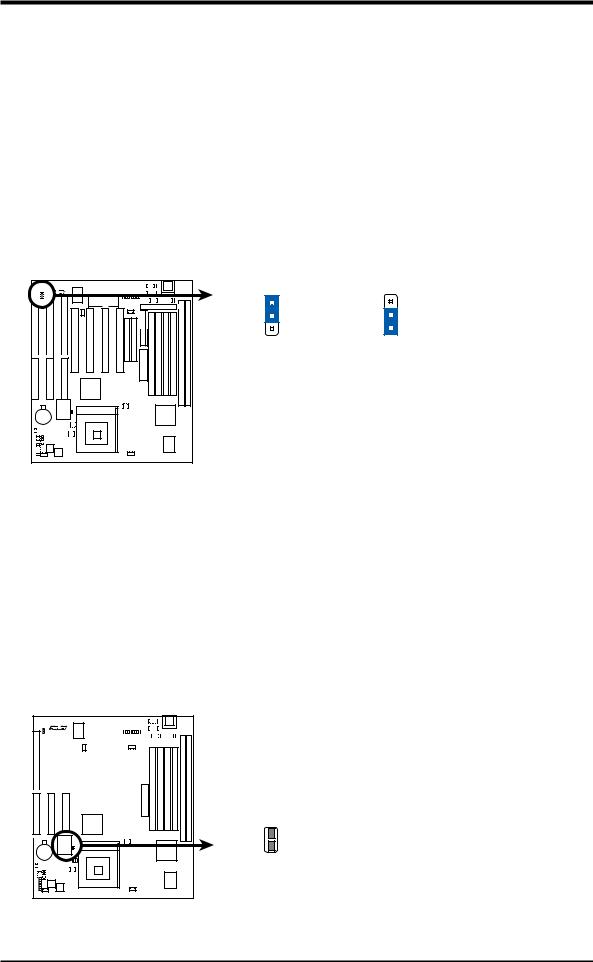
III. INSTALLATION
Jumper Settings
1.Flash ROM Boot Block Programming (BBLKW)
This sets the operation mode of the boot block area of the Programmable Flash ROM to allow programming in the Enabled position. This is required only if prompted by the Flash Memory Writer Utility as shown in BIOS SOFTWARE.
Programming BBLKW
Disabled |
[1-2] (Default) |
Enabled [2-3]
BBLKW |
BBLKW |
Disabled/Protect |
Enabled |
(Default) |
|
TXP4 Boot Block Programming
2.Real Time Clock (RTC) RAM (CLRTC)
The CMOS RAM is powered by the onboard button cell battery. To clear the RTC data: (1) Turn off your computer, (2) Short solder points using a small metalic object, (3) Turn on your computer, (4) Hold down <Delete> during bootup and enter BIOS setup to re-enter user preferences.
RTC RAM |
|
|
|
CLRTC |
|||||||||||||||||||
Clear Data |
|
|
|
[short solder points momentarily] |
|||||||||||||||||||
|
|
|
|
|
|
|
|
|
|
|
|
|
|
|
|
|
|
|
|
|
|
|
|
|
|
|
|
|
|
|
|
|
|
|
|
|
|
|
|
|
|
|
|
|
|
|
|
|
|
|
|
|
|
|
|
|
|
|
|
|
|
|
|
|
|
|
|
|
|
|
|
|
|
|
|
|
|
|
|
|
|
|
|
|
|
|
|
|
|
|
|
|
|
|
|
|
|
|
|
|
|
|
|
|
|
|
|
|
|
|
|
|
|
|
|
|
|
|
|
|
|
|
|
|
|
|
|
|
|
|
|
|
|
|
|
|
|
|
|
|
|
|
|
|
|
|
|
|
|
|
|
|
|
|
|
|
|
|
|
|
|
|
|
|
|
|
|
|
|
|
|
|
|
|
|
|
|
|
|
|
|
|
|
|
|
|
|
|
|
|
|
|
|
|
|
|
|
|
|
|
|
|
|
|
|
|
|
|
|
|
|
|
|
|
|
|
|
|
|
|
|
|
|
|
|
|
|
|
|
|
|
|
|
|
|
|
|
|
|
|
|
|
|
|
|
|
|
|
|
|
|
|
|
|
|
|
|
|
|
|
|
|
|
INSTALLATION |
(Jumpers) |
III. |
|
|
|
CLRTC
Short solder points to Clear Data
TXP4 RTC RAM (Clear Data)
ASUS TXP4 User’s Manual |
15 |

INSTALLATION .III (Jumpers)
III.INSTALLATION
3.CPU External (BUS) Frequency Selection (FS0, FS1, FS2)
These jumpers tell the clock generator what frequency to send to the CPU. These allow the selection of the CPU’s External frequency (or BUS Clock). The BUS Clock times the BUS Ratio equals the CPU'sInternal frequency (the advertised CPU speed).
4.CPU to BUS Frequency Ratio (BF0, BF1, BF2)
These jumpers set the frequency ratio between the Internal frequency of the CPU and the External frequency (called the BUS Clock) within the CPU. These must be set together with the above jumpers CPU External (BUS) Frequency Selection.
WARNING! Frequencies above 66MHz exceed the specifications for the onboard Intel Chipset and are not guaranteed to be stable. The following table is for general reference purposes only. Always refer to the instructions included with your CPU when possible.
|
FS2 FS1 FS0 |
FS2 FS1 FS0 |
FS2 FS1 FS0 |
FS2 FS1 FS0 |
FS2 FS1 FS0 |
FS2 FS1 FS0 |
|
||||||
|
1 |
1 |
|
1 |
1 |
1 |
|
1 |
2 |
2 |
|
2 |
2 |
2 |
|
2 |
3 |
3 |
|
3 |
3 |
3 |
|
3 |
|
50MHz |
55MHz |
60MHz |
|
66MHz |
75MHz |
83MHz |
CPU External Clock (BUS) Frequency Selection
BF2 BF1 BF0 |
BF2 BF1 BF0 |
BF2 BF1 BF0 |
BF2 BF1 BF0 |
BF2 BF1 BF0 |
BF2 BF1 BF0 |
1 |
1 |
1 |
1 |
1 |
1 |
2 |
2 |
2 |
2 |
2 |
2 |
3 |
3 |
3 |
3 |
3 |
3 |
|
|
|
|
|
|
|
|
|
|
|
|
|
CPU A |
|
1.5x(3/2) |
2.0x(2/1) |
2.5x(5/2) |
3.0x(3/1) |
---- |
---- |
|
|
|
|
|
|
|
|
|
|
|
|
|
|
|||||||
|
|
|
|
|
|
|
|
|
|
|
|
|
|
|||||||
|
|
|
|
|
|
|
|
|
|
|
|
|
CPU B |
|
3.5x(7/2) |
2.0x(2/1) |
2.5x(5/2) |
3.0x(3/1) |
---- |
---- |
|
|
|
|
|
|
|
|
|
|
|
|
|
||||||||
|
|
|
|
|
|
|
|
|
|
|
|
|
||||||||
|
|
|
|
|
|
|
|
|
|
|
|
|
|
|||||||
TXP4 CPU Settings |
CPU C |
|
3.0x(3/1) |
2.0x(2/1) |
1.0x(1/1) |
---- |
---- |
---- |
||||||||||||
|
||||||||||||||||||||
Match the table’s Ratio |
CPU D |
|
3.0x(3/1) |
2.0x(2/1) |
2.0x(2/1) |
---- |
---- |
---- |
||||||||||||
|
||||||||||||||||||||
CPU E |
|
3.5x(7/2) |
2.0x(2/1) |
2.5x(5/2) |
3.0x(3/1) |
4.0X(4/1) (4.5X)(9/2) |
||||||||||||||
column to these CPU types: |
|
|||||||||||||||||||
|
|
|
|
|
|
|
|
|||||||||||||
CPU : BUS Frequency Ratio
16 |
ASUS TXP4 User’s Manual |

III. INSTALLATION
Set the jumpers by the Internal speed of the Intel, AMD, IBM, or Cyrix CPU as follows:
CPU Model |
Freq. |
Intel Pentium P54C |
166MHz |
Intel Pentium P54C |
150MHz |
Intel Pentium P54C |
133MHz |
Intel Pentium P54C |
120MHz |
Intel Pentium P54C |
100MHz |
Intel Pentium P54C |
90MHz |
Intel Pentium P54C |
75MHz |
AMD-K5-PR133 |
100MHz |
AMD-K5-PR120 |
90MHz |
AMD-K5-PR100 |
100MHz |
AMD-K5-PR90 |
90MHz |
AMD-K5-PR75 |
75MHz |
Intel Pentium P55C |
233MHz |
Intel Pentium P55C |
200MHz |
Intel Pentium P55C |
166MHz |
IBM/Cyrix 6x86MX-PR233 |
200MHz |
IBM/Cyrix 6x86MX-PR200 |
166MHz |
IBM/Cyrix 6x86MX-PR166 |
150MHz |
*IBM/Cyrix 6x86-PR166+ 133MHz *IBM/Cyrix 6x86L-PR166+ 133MHz
AMD-K6-PR233 233MHz
AMD-K6-PR200 200MHz
AMD-K6-PR166 166MHz
|
|
|
|
|
|
|
|
|
|
|
|
|
|
|
|
|
|
(BUS Freq.) |
(Freq. Ratio) |
|
|||||
|
|
|
|
|
|
|||||||
Ratio |
BUS F. |
FS0 |
FS1 |
FS2 |
BF0 |
BF1 |
BF2 |
|||||
A-2.5x |
66MHz |
[2-3] |
[1-2] |
[2-3] |
[2-3] |
[2-3] |
[---- |
] |
||||
A-2.5x |
60MHz |
[1-2] |
[2-3] |
[2-3] |
[2-3] |
[2-3] |
[---- |
] |
||||
A-2.0x |
66MHz |
[2-3] |
[1-2] |
[2-3] |
[2-3] |
[1-2] |
[---- |
] |
||||
A-2.0x |
60MHz |
[1-2] |
[2-3] |
[2-3] |
[2-3] |
[1-2] |
[---- |
] |
||||
A-1.5x |
66MHz |
[2-3] |
[1-2] |
[2-3] |
[1-2] |
[1-2] |
[---- |
] |
||||
A-1.5x |
60MHz |
[1-2] |
[2-3] |
[2-3] |
[1-2] |
[1-2] |
[---- |
] |
||||
A-1.5x |
50MHz |
[2-3] |
[2-3] |
[2-3] |
[1-2] |
[1-2] |
[---- |
] |
||||
A-1.5x |
66MHz |
[2-3] |
[1-2] |
[2-3] |
[1-2] |
[1-2] |
[---- |
] |
||||
A-1.5x |
60MHz |
[1-2] |
[2-3] |
[2-3] |
[1-2] |
[1-2] |
[---- |
] |
||||
A-1.5x |
66MHz |
[2-3] |
[1-2] |
[2-3] |
[1-2] |
[1-2] |
[---- |
] |
||||
A-1.5x |
60MHz |
[1-2] |
[2-3] |
[2-3] |
[1-2] |
[1-2] |
[---- |
] |
||||
A-1.5x |
50MHz |
[2-3] |
[2-3] |
[2-3] |
[1-2] |
[1-2] |
[---- |
] |
||||
B-3.5x |
66MHz |
[2-3] |
[1-2] |
[2-3] |
[1-2] |
[1-2] |
[---- |
] |
||||
B-3.0x |
66MHz |
[2-3] |
[1-2] |
[2-3] |
[1-2] |
[2-3] |
[---- |
] |
||||
B-2.5x |
66MHz |
[2-3] |
[1-2] |
[2-3] |
[2-3] |
[2-3] |
[---- |
] |
||||
B-3.0x |
66MHz |
[2-3] |
[1-2] |
[2-3] |
[1-2] |
[2-3] |
[---- |
] |
||||
B-2.5x |
66MHz |
[2-3] |
[1-2] |
[2-3] |
[2-3] |
[2-3] |
[---- |
] |
||||
B-2.5x |
60MHz |
[1-2] |
[2-3] |
[2-3] |
[2-3] |
[2-3] |
[---- |
] |
||||
C-2.0x |
66MHz |
[2-3] |
[1-2] |
[2-3] |
[2-3] |
[1-2] |
[---- |
] |
||||
D-2.0x |
66MHz |
[2-3] |
[1-2] |
[2-3] |
[2-3] |
[1-2] |
[---- |
] |
||||
E-3.5x |
66MHz |
[2-3] |
[1-2] |
[2-3] |
[1-2] |
[1-2] |
[---- |
] |
||||
E-3.0x |
66MHz |
[2-3] |
[1-2] |
[2-3] |
[1-2] |
[2-3] |
[---- |
] |
||||
E-2.5x |
66MHz |
[2-3] |
[1-2] |
[2-3] |
[2-3] |
[2-3] |
[---- |
] |
||||
*NOTE: The only IBM or Cyrix 6x86(L) (or M1) that is supported on this motherboard is revision 2.7 or later. (see next page).
INSTALLATION |
(Jumpers) |
III. |
|
|
|
ASUS TXP4 User’s Manual |
17 |
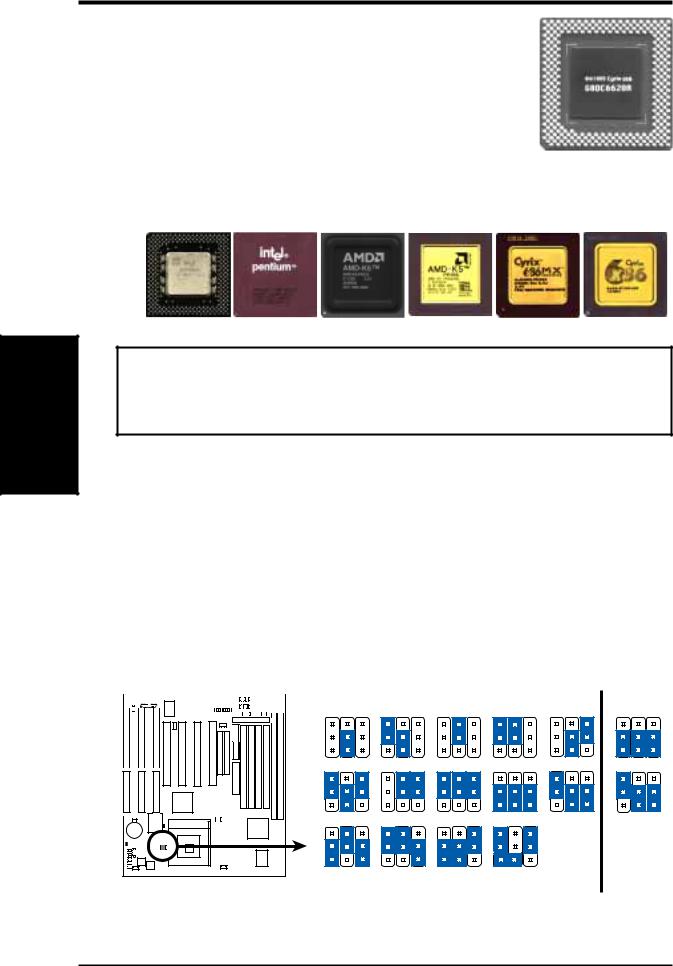
III. INSTALLATION
Compatible Cyrix CPU Identification
The only Cyrix 6x86-PR166+ CPU that is supported on this motherboard must be Revision 2.7 or later. Look on the underside of the CPU for the serial number. The number should read G8DC6620A or later.
5.Voltage Regulator Output Selection (VID0, 1, 2)
These jumpers set the voltage supplied to the CPU. Switching regulators allow some jumper settings to be the same for two voltages of different power planes.
INSTALLATION .III (Jumpers)
Pentium MMX (P55C) Intel Pentium (P54C) |
AMD-K6 |
AMD-K5 |
IBM/Cyrix 6x86(MX) |
IBM/Cyrix 6x86(M1) |
(150MHz-233MHz) (75MHz-200MHz) |
(PR166 and faster) |
(PR75-PR133) |
(PR166 and faster) |
(PR166 and faster) |
WARNING! Because CPU designs change rapidly, the table below is only intended as a simple guideline and thus may not be true for your CPU. Always refer to the CPU documentation for your CPU’s voltage and then set the appropriate VID jumpers according to the illustration below.
|
Manufacturer |
CPU Type |
Single Plane |
Dual Plane |
VID0 |
VID1 |
VID2 |
||||||||||||||||||||||
|
Intel |
P54C/P54CS |
3.5V(VRE) |
---- |
|
[1-2] |
[2-3] |
[2-3] |
|||||||||||||||||||||
|
AMD |
K5 |
3.5V(VRE) |
---- |
|
[1-2] |
[2-3] |
[2-3] |
|||||||||||||||||||||
|
IBM/Cyrix |
6x86 |
3.5V(VRE) |
---- |
|
[1-2] |
[2-3] |
[2-3] |
|||||||||||||||||||||
|
Intel |
P54C/P54CS |
3.4V(STD) |
---- |
|
[2-3] |
[2-3] |
[2-3] |
|||||||||||||||||||||
|
AMD |
K5 |
3.4V(STD) |
---- |
|
[2-3] |
[2-3] |
[2-3] |
|||||||||||||||||||||
|
AMD (.35micron) |
K6-PR233 |
---- |
|
3.2V(Dual) |
[2-3] |
[2-3] |
[1-2] |
|||||||||||||||||||||
|
AMD (.35micron) |
K6-166,200 |
---- |
|
2.9V(Dual) |
[1-2] |
[2-3] |
[2-3] |
|||||||||||||||||||||
|
IBM/Cyrix |
6x86MX |
---- |
|
2.9V(Dual) |
[1-2] |
[2-3] |
[2-3] |
|||||||||||||||||||||
|
Intel |
P55C-MMX |
---- |
|
2.8V(Dual) |
[2-3] |
[2-3] |
[2-3] |
|||||||||||||||||||||
|
|
|
|
|
|
|
|
||||||||||||||||||||||
|
AMD (.25micron) |
K6-233,266,300 |
---- |
|
2.2V(Dual) |
[----] [1-2] |
[----] |
||||||||||||||||||||||
|
|
|
|
|
|
|
|
|
|
|
|
|
|
|
|
|
|
|
|
|
|
VID2 VID1 VID0 |
VID2 VID1 VID0 |
VID0 |
VID2 VID1 |
VID2 VID1 VID0 |
VID1 VID0 |
VID2 |
VID2 VID1 VID0 |
|
|
|
|
|
|
|
|
|
|
|
|
|
|
|
|
|
|
|
|
|
|
||||||||
1 |
1 |
1 |
|
1 |
1 |
1 |
2 |
2 |
2 |
|
2 |
2 |
2 |
3 |
3 |
3 |
|
3 |
3 |
3 |
2.0Volts |
|
2.1Volts |
2.2Volts |
2.3Volts |
2.4Volts |
3.4V (STD) |
1 |
1 |
|
1 |
1 |
1 |
1 |
2 |
2 |
|
2 |
2 |
2 |
2 |
3 |
3 |
|
3 |
3 |
3 |
3 |
2.5Volts |
|
2.6Volts |
2.7Volts |
2.8Volts |
2.9Volts |
3.5V (VRE) |
1 |
1 |
|
1 |
1 |
|
|
2 |
2 |
|
2 |
2 |
|
|
3 |
3 |
|
3 |
3 |
|
|
3.0Volts |
|
3.1Volts |
3.2Volts |
3.3Volts |
|
Single Plane |
TXP4 CPU Vcore Voltage Selection |
|
Dual Plane CPU |
|
|
||
18 |
ASUS TXP4 User’s Manual |

III.INSTALLATION
2.System Memory (SIMM & DIMM)
This motherboard supports four 72-pin, 32-bit SIMMs (Single Inline Memory Modules) of 4, 8, 16, 32, or 64MB to form a memory size between 8MB to 256MB. The SIMMs can be either 60ns or 70ns Fast Page Mode (FPM) (Asymmetric or Symmetric), or Enhanced Data Out (EDO) (BEDO & Parity are not supported). SIMMs must be installed in pairs so that each Row (see motherboard layout for row locations) contains 64-bits of the same size and type of memory chips. One side (with memory chips) of the SIMM module takes up half a row on the motherboard.
Dual Inline Memory Modules (DIMMs) can be used when the SIMM sockets are not used. Two sockets are available for 3.3Volt (power level) Unbuffered Synchronous DRAMs (SDRAM) or EDO DRAM of either 8, 16, 32, 64, 128, 256MB to form a memory size between 8MB to 256MB. One side (with memory chips) of the DIMM module takes up one row on the motherboard.
IMPORTANT: Memory speed setup is required through “Auto Configuration” in BIOS Chipset Setup of the BIOS SOFTWARE. If both 60ns and 70ns memory are used, set “Auto Configuration” to 70ns. Do not use memory modules with more than 18 chips per module. Modules with more than 18 chips exceed the design specifications of the memory subsystem and will be unstable.
Memory Socket |
SIMM Memory Module |
|
Total Memory |
|
|
|
|
SIMM Sockets 1&2 |
4MB, 8MB, 16MB, 32MB, 64MB |
x2 |
|
(Rows 0 & 1) |
72-pin FPM or EDO SIMM |
|
|
|
(DIMM Sockets must be empty) |
|
|
|
|
|
|
SIMM Sockets 3&4 |
4MB, 8MB, 16MB, 32MB, 64MB |
x2 |
|
(Rows 2 & 3) |
72-pin FPM or EDO SIMM |
|
|
|
(DIMM Sockets must be empty) |
|
|
|
|
|
|
|
Total System Memory (Max 256MB) |
= |
|
|
|
|
|
WARNING! Do not install both SIMMs and DIMMs at the same time or else you will burn your memory. Mixing SIMMs and DIMMs require 5.0Volt (signal level) tolerant memory chips which are currently unavailable.
Memory Socket |
DIMM Memory Module |
|
Total Memory |
|
|
|
|
DIMM Socket 1 |
8, 16, 32, 64, 128, 256MB |
x1 |
|
(Rows 0 & 1) |
168-pin SDRAM or EDO DIMM |
|
|
|
(SIMM Sockets must be empty) |
|
|
|
|
|
|
DIMM Socket 2 |
8, 16, 32, 64, 128, 256MB |
x1 |
|
(Rows 2 & 3) |
168-pin SDRAM or EDO DIMM |
|
|
|
(SIMM Sockets must be empty) |
|
|
|
|
|
|
|
Total System Memory (Max 256MB) |
= |
|
|
|
|
|
III. INSTALLATION (System Memory)
ASUS TXP4 User’s Manual |
19 |
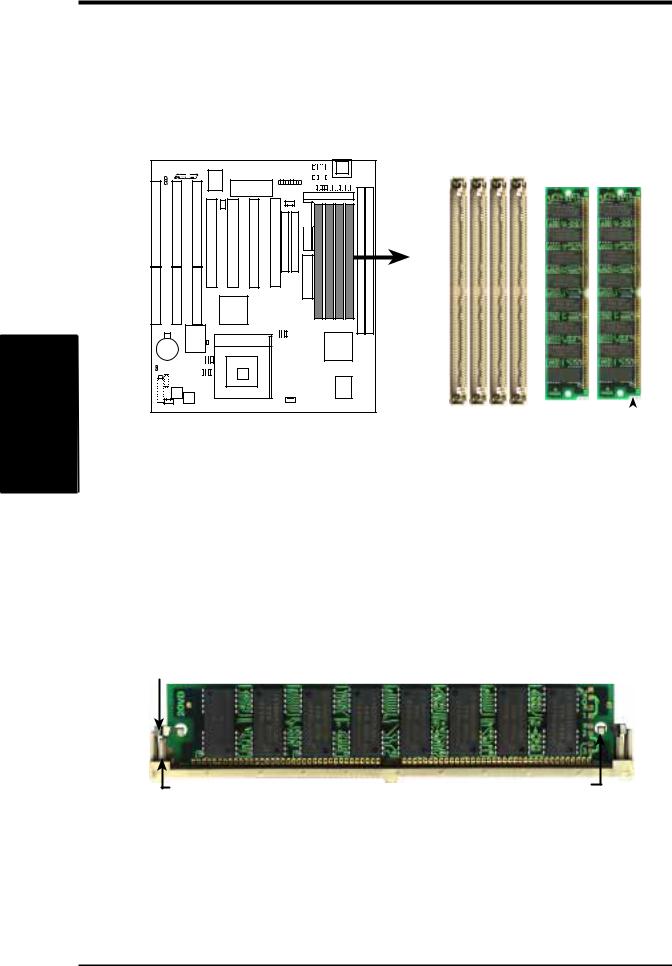
INSTALLATION .III Memory) (System
III. INSTALLATION
SIMM Memory Installation
1.The SIMM memory modules will fit in only one orientation as shown because the plastic safety tab on one end of the SIMM sockets requires the notched end of the SIMM memory modules.
1 2 3 4
Notched End 
TXP4 72 Pin SIMM Sockets
2.Press the memory module firmly into place starting from a 45-degree angle, making sure that all the contacts are aligned with the socket.
3.With your fingertips, rock the memory module into a vertical position so that it clicks into place. The plastic guides should go through the two mounting holes and the support clips should snap.
Clip |
72 Pin DRAM in SIMM Socket |
Plastic Safety Tab (This Side Only) |
Mounting Hole |
To release the memory module, push both support clips outward and rock the module out of the support clips.
20 |
ASUS TXP4 User’s Manual |
